When I teach my defensive knife courses, at least one student always says, “I’d rather defend against a handgun than a knife. Knives scare me more than guns!”
I’m sure you have also heard it and perhaps have even said it yourself. The perception that knives are more intimidating than guns appears to be common. It intrigues me because it clearly influences the students’ mindset, which in turn reduces their ability to defend themselves effectively.
Self-defense programs, especially those that incorporate weapons, must be designed to develop the appropriate mindset and resolve in the student so the tactics can be applied decisively. When students are taught tactics alone, disregarding the psychological aspect of defending against and using a weapon, the exercise is futile and sets the students up for failure. As an instructor, I feel a strong responsibility to research the fear-based response to knives so I can help my students manage that fear successfully and become better able to protect themselves and their loved ones.
Fear can have a positive effect on our survival. Unfortunately, if we cannot manage it, it devolves into anxiety and panic. Panic, on the other hand, has a detrimental effect on our survival because it causes wildly irrational thinking and behavior. The more clearly the students understand and articulate the origins of their fear of knives, the less this fear will be able to control them.
In this three-part article, I will share the research I’ve conducted on the emotional components of knife defense, my understanding of why most people seem to fear knives more than guns, and how to change this mindset through training. While reviewing this information, be aware that it is not meant as the final word on the subject, but rather as a starting point for further research and discussion. I hope you will find it helpful.
- Handguns can deliver a lot of damage in a very short time, with little physical exertion.
- Bullets generally create more physiological trauma than knives. For example, 68% of victims stabbed in the heart survive, while only 14% survive being shot in the heart (The Pathology of Trauma, J.K. Mason and B.N. Purdue, 2000).
- Handguns can be used outside of contact distance, where it is much more difficult to defend against being shot. Have you seen any instructional videos on gun disarms during which the attacker holds the gun more than two feet away from the defender? I would venture to guess you have not.
- Handguns produce small explosions, with loud noises and flames, and launch very fast projectiles, all things that we instinctively fear and want to avoid.
Yet, on an emotional level, to most students the thought of a blade coming toward them trumps all that!
The question is: Why?
Below, I present several hypotheses that have been formulated about this phenomenon. I explore each hypothesis and provide thoughts and expert opinion.
Hypothesis 1: Survival Instinct Bias
If we look at the fear of knives from a survival instinct perspective, our response to the danger of a knife attack is likely embedded in our genes from millennia of natural selection. Knife defense is not a new phenomenon. Human beings have defended against blunt objects, sharp objects, and blades for far longer than they have had the need to defend against firearms. The first recognized edged tools were developed during the Stone Age, approximately 2.5 million years ago, when people began to fashion simple hunting tools from flint and obsidian.
Firearms, on the other hand, have only existed for a few centuries. Could this be the reason most people have a much stronger aversion to knives?
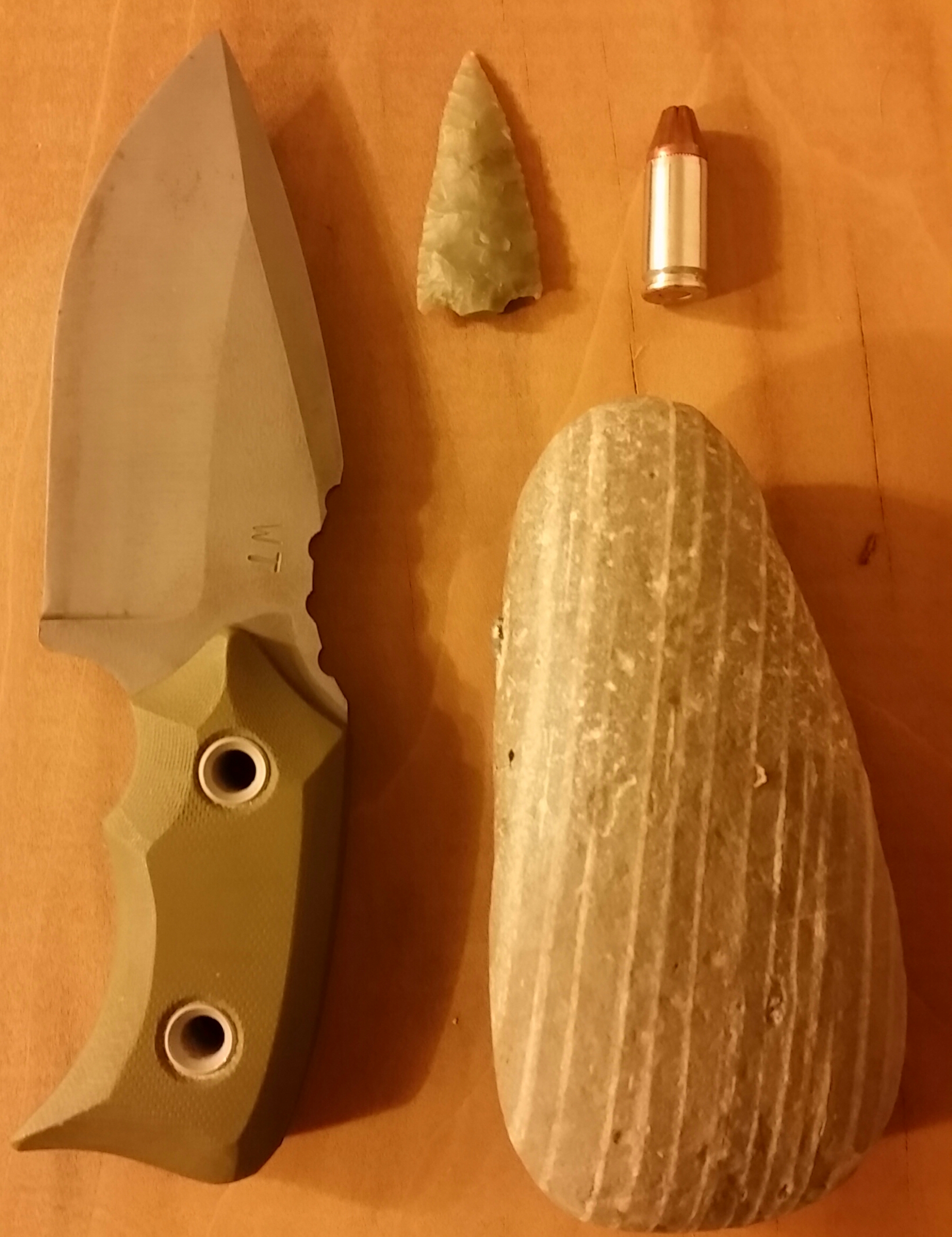
It doesn’t matter the weapon — our limbic system reacts to all of them in the same way. Photo: author
Takeaways
- Our instinctive reactions upon being threatened by a gun or a knife are the same.
- Our emotional reaction can be very different in intensity. The bias is emotional, not instinctive.
Hypothesis 2: Prior Experience
Another factor that may affect a person’s response to a knife threat is a widespread familiarity with the amount of damage a blade can inflict. People use knives every day for a variety of tasks and are aware of their capabilities. Most people have cut themselves by accident while cutting vegetables for dinner or opening a well-sealed package. We are familiar with the effect a blade has on flesh, not only cognitively, such as for the imagined effect of getting shot, but on a more intimate and emotional level. When you last cut your hand, do you remember the sound the knife edge made on your flesh — no matter how big or small the cut — the warm, bright blood, the stitches, and the pain? Yes? You are not alone: most people hold onto such memories, likely because of the value of avoiding the danger in the future.
This idea gained more traction after I read an article by Dr. Karl Albrecht entitled “The (Only) 5 Fears We All Share” (Psychology Today, March 2012). Dr. Albrecht makes some interesting points that are pertinent to our discussion:
- He describes fear as an anxious feeling caused by our anticipation of some imagined event or experience (experience = memory).
- He explains fear of mutilation, one of the five fears common to all human beings: “the fear of losing any part of our precious bodily structure; the thought of having our body’s boundaries invaded…”
I propose that the fear of mutilation provides no major distinctions between the fear of getting shot and the fear of getting cut or stabbed. Interestingly, Dr. Albrecht discusses President Franklin D. Roosevelt’s famous quote: “The only thing we have to fear is fear itself.” He explains that the idea of fearing our fears becomes less strange when we realize that many of our avoidance reactions are in response to the memories of fear.
Takeaways
- Most people are more familiar with the damage a blade can do and have a memory (experience) of getting cut, while they are not likely to have a memory of getting shot.
- This important distinction may play a role in the difference of our fear response to the knife.
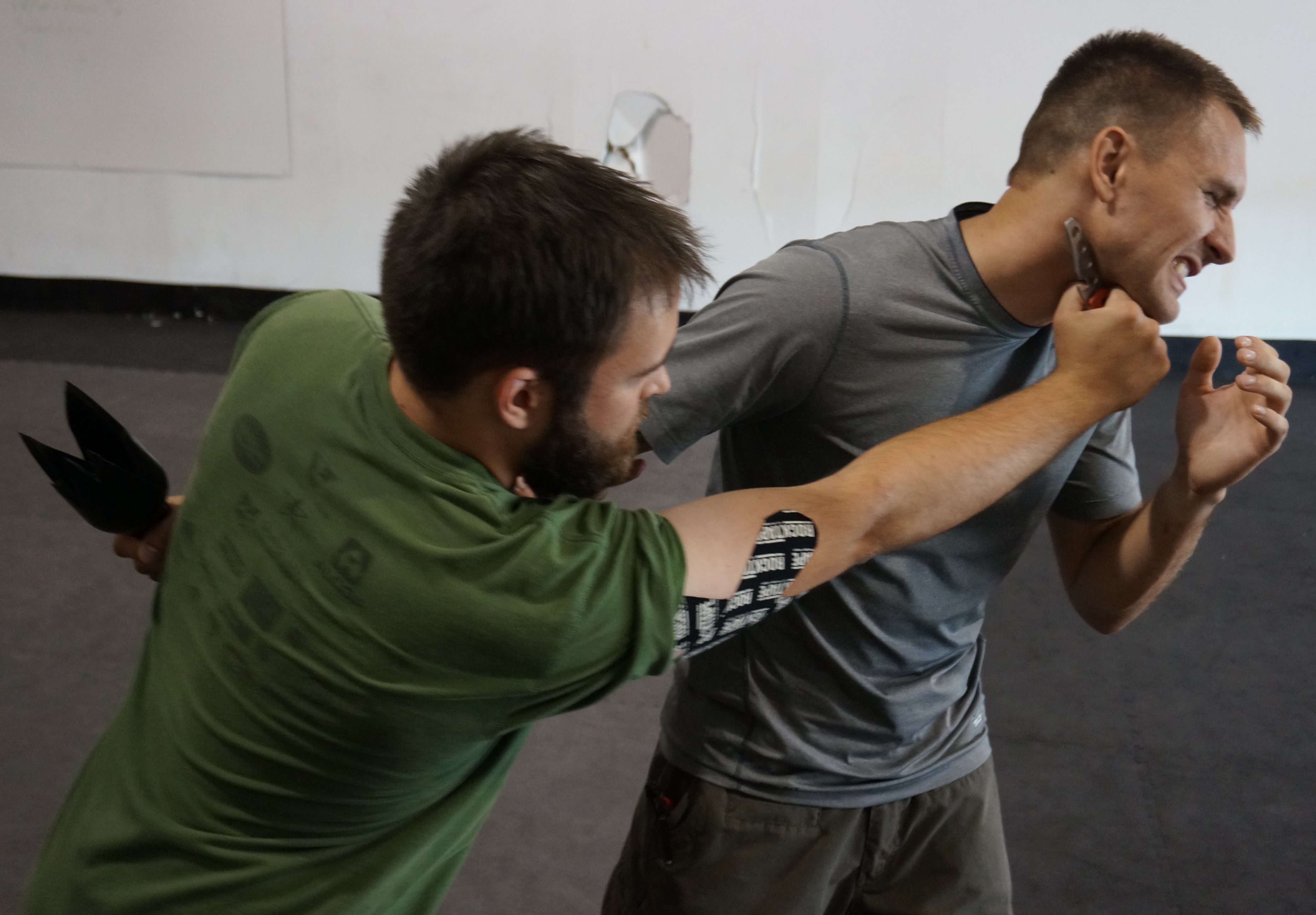
Students’ memories of being cut with a knife rise to the surface during knife defense training.
Photo: author
So Far So Good, Or So I Thought!
One day I was discussing some of these ideas with a friend who, in the course of his long career as a Special Forces soldier and armed professional, had been shot and stabbed multiple times on separate occasions. Although the physical damage from his gunshot wounds was, on average, much more severe than the damage he received from his knife wounds, he confided that he too was more afraid of the knife than the gun. He actually gets uncomfortable around knives, even when people at his work grab their pocket knife to carry out any mundane tasks. He gets a strong emotional reaction with increased heart rate and hypervigilance. Yet he still trains regularly with firearms, both on his own and with other students, with no adverse emotional reaction.
Here is a guy who has fear memories both of getting shot and getting stabbed. He understands that gunshots are generally harder to survive than knife wounds … and he still fears the blade more. He’s not alone in this. I’ve talked with a few other individuals with similar backgrounds and experiences, and most share his emotions. Although these individuals are too few to gain meaningful conclusion from, their experience makes me wonder what else influences our fear of the knife.
Hypothesis 3: The Knife Is Personal
Something else that piqued my curiosity was the fact that once the class progresses to where the students start to apply on a training partner the knife defense tactics they have learned, nervous laughter can be heard, and something along the lines of “Gross! I’d rather use a gun to defend myself than a knife” is another oft-repeated phrase.
At first, this statement seem at odds with “I’d rather defend against a handgun than a knife. Knives scare me more than guns!” After all, if someone deems a certain weapon more dangerous, why wouldn’t they want to use it to defend themselves?
But when you analyze the two statements more in depth, you realize they stem from the same emotional issues. The blade is a much more intimate tool than the gun. It is used at contact distance. It’s messy and bloody, the very definition of gruesome. As such, the thought of defending against it inspires more fear, and the thought of using it on another human being elicits more revulsion. For our purposes, it is imperative to understand the origin of this revulsion to using a knife on a fellow human being.
It is a well-known fact that most people have an innate reticence toward hurting and killing other human beings. There are a few evolutionary biology theories about this, with the common denominator being that since we have a better chance to survive and procreate when we are part of a group, we needed an innate set of emotional responses that would help us manage our aggressive behavior and inhibit our violent tendencies to better fit in with our family, tribe, society.
“Evolution dealt with this species-threatening conflict between our violence and our close-knit social life by building guilt, shame, and anxiety into our genes. These inhibiting emotions were needed prehistorically to control our self-assertiveness and aggression within intimate family and clan relationships.” (Guilt, Shame, and Anxiety: Understanding and Overcoming Negative Emotions, Peter R. Breggin, M.D., 2014)
In his book On Killing: The Psychological Cost of Learning To Kill in War and Society, Lt. Col. Dave Grossman writes at length about this widespread resistance to killing and analyzes the psychological differences between killing at different ranges:
“The link between distance and ease of aggression is not a new discovery. It has long been understood that there is a direct relationship between the emphatic and physical proximity of the victim and the resulting difficulty and trauma of the kill.”
And with different tools:
Incidentally, modern homicide statistics seem to support this notion by showing that when these inhibitions are absent, as in people with marked sociopathic and psychopathic characteristics, the opposite behavior is true: “Multiple stabbing occurs significantly more frequently in sex-related homicides than in other homicide types.” (Naftali Berrill, Forensic Psychologist)
About the use of a knife during combat, Lt. Col. Grossman explains that “As we bring the physical distance spectrum down to its culmination point, we must recognize that killing with a knife is significantly more difficult than killing with the bayonet affixed to the end of a rifle.”
Takeaways
- The average human being has a strong innate resistance to hurting and killing a fellow human being. This resistance increases as distance decreases. It increases further when we add a contact weapon and further still with the modality of the strike: slash vs. stab.
- The intimate brutality and gruesomeness of a knife attack are likely the main reasons for our more intense fear response to the blade.
Conclusions
It seems that this disproportionate fear of the knife is based on an emotional bias fueled by familiarity with the tool, prior negative experiences with its capability, and our innate emotional and psychological responses to hurting other people or being hurt, which are exacerbated by close distances and by using a blade.
Interesting. But knowledge alone, without a way for it to influence our training methodology, is pretty useless.
In Part 2, we’ll look at how to successfully integrate this knowledge into our knife defense training program in order to mitigate these detrimental effects to our ability to defend ourselves as efficiently as possible.
Posted by Alessandro Padovani
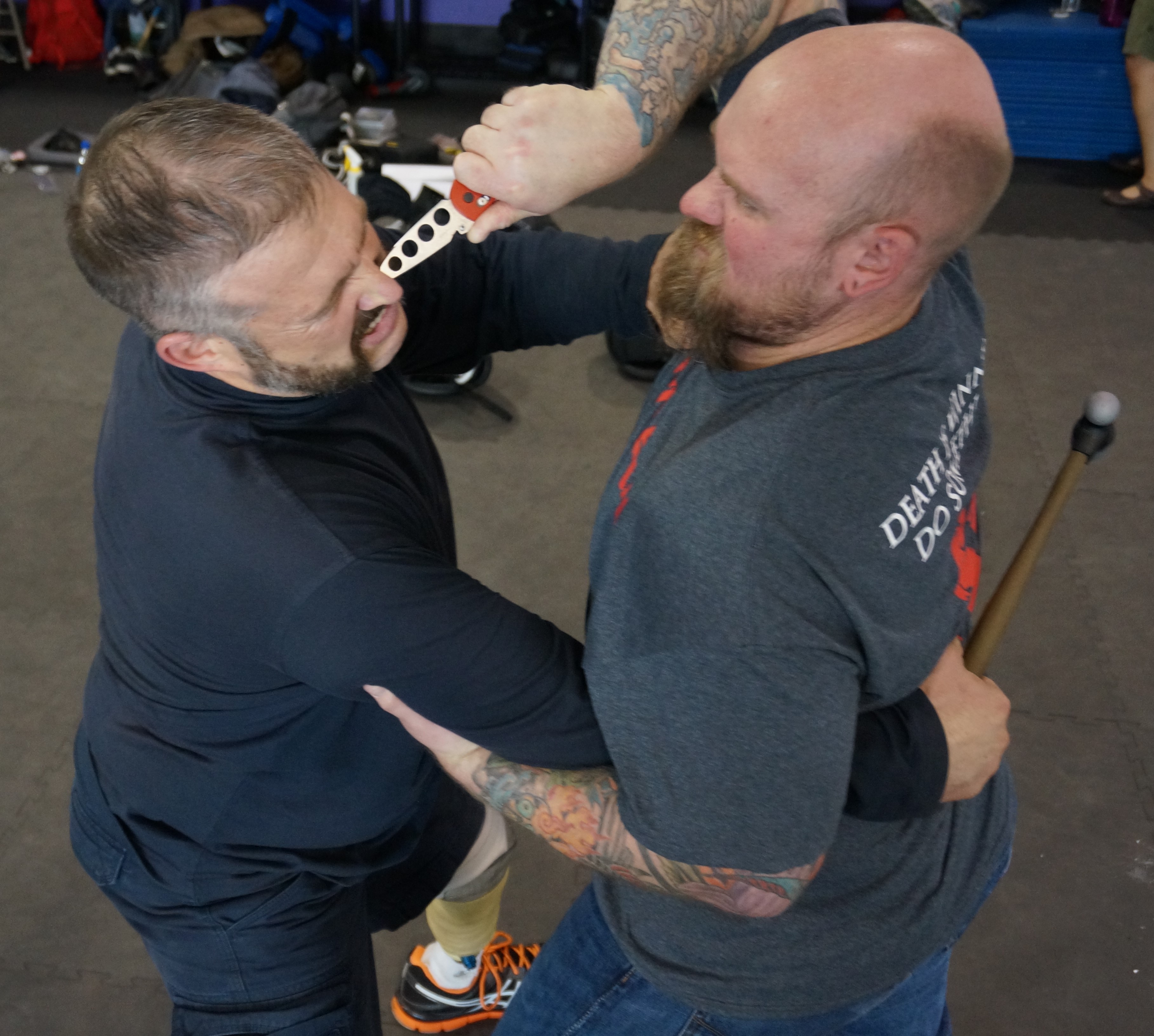
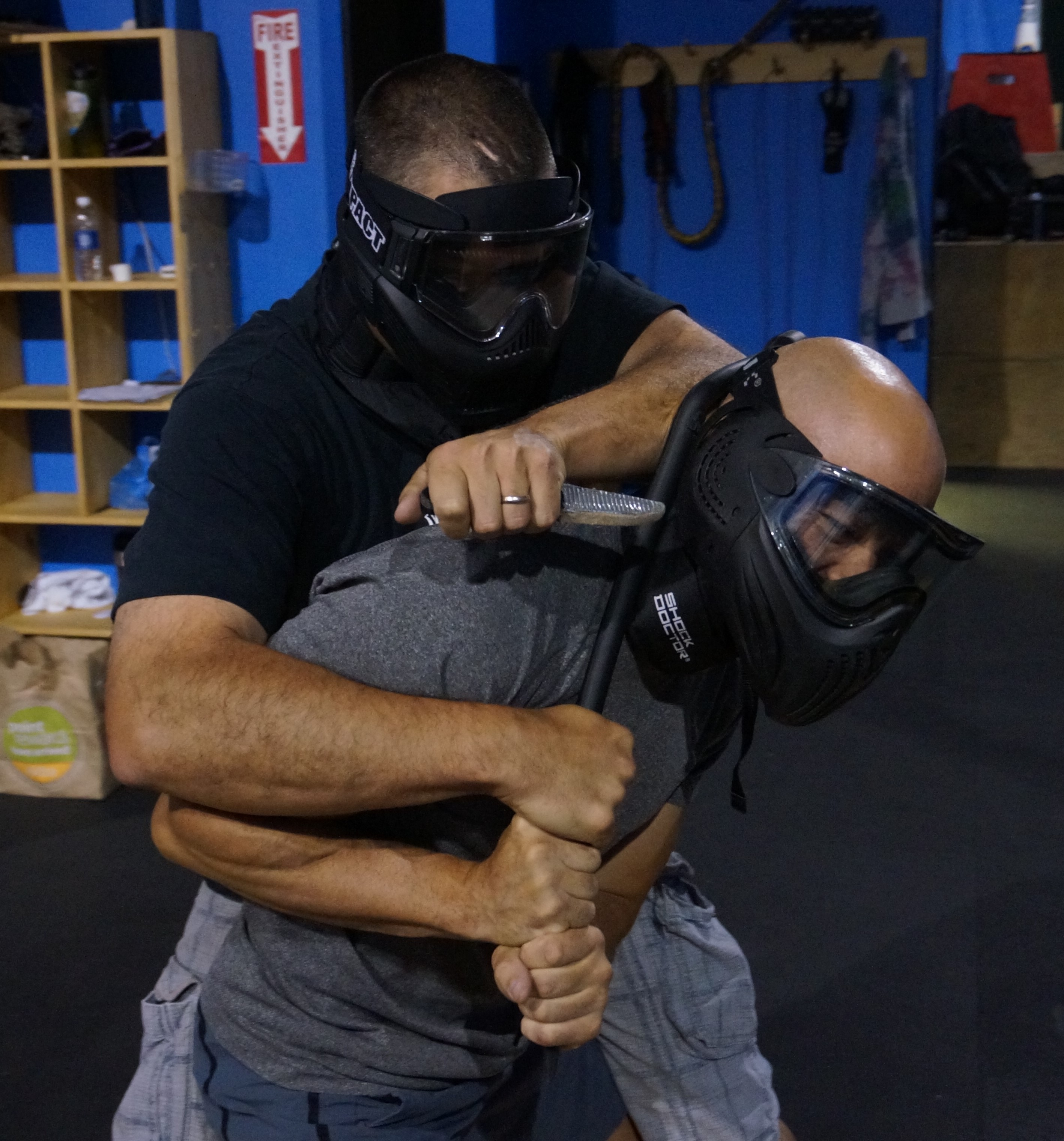
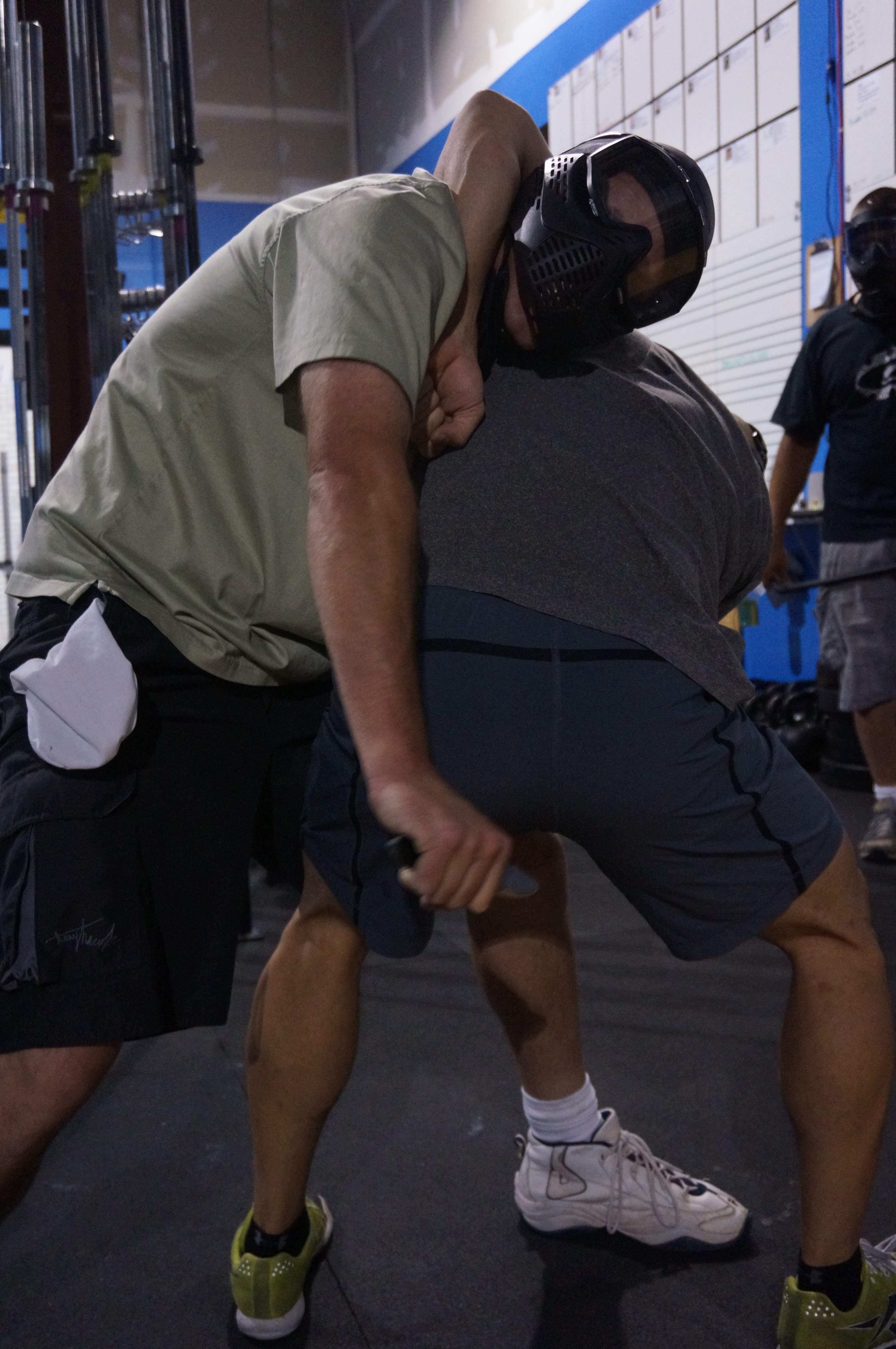
Great observations, thx and you're right, knives arouse different 'feelings' with different folks. Reminds me of a former neighbor who was very big on guns, and always packed a conspicuous 9mm Glockon his hip wherever he'd go. And the possibility of dealing with other armed adversaries didn't seem to bother him, in fact I suspect he woulda 'welcomed' it. Yet he would also conspicuously avoid any 'hispanic' neighborhoods, remarking once that "those guys really like their KNIVES!"
The last person that I would go to is an evolutionist or a psychologist, both discredited "sciences." God gave us a conscience and a law, thou shalt not murder, and, also, told us that the law is summed up by loving our neighbor as we love ourselves. Unfortunately, we live in a world where people have not learned those laws.
Movies also bring the closeness of the vivid close quarters trauma of knife fighting. The knife scene in Saving Private Ryan haunts me. The smaller GI was without his equalizer (gun) and died a painful agonized slow death. The distance factor is very true. We don’t want people in our personal space. A gun helps to maintain this.
Excellent read. Very valuable and has changed my perspective on the blade. As a marital artist I will be incorporating edge weapons into my profile.
Good points. I conceal carry when I can, but my job precludes this. I can and do always carry a knife however. Perhaps, a bit of topic, but important nevertheless. Get a good locking knife if you chose to carry. I had a cheap one fold back on my hand while using it against a criminal in a fight. Also practice opening it a lot. When the moment comes to use it, you will be glad you did. Good discussion, and I really like the knife defense videos.
Read all of every ones responses, and the best one was from Boaz. Personal experience trumps perceived actions any day. I thank you for your sharing of such a personal experience. And so glad you survived. 3 years ago I was walking out of a Mall and right into a small gang dispute (4 on one side of lot and 6 on the other) Funny both sides stopped everything and were looking at me. My hand went under my shirt to my pistol but stayed there covered by my shirt, I kept my composure and nodded first to one side and then to the other to both gangs. they just looked at me and I continued walking, not even a comment from either side. The Police arrived just as I was getting into my car. Moral of story: Never, Ever NOT be aware of your surroundings and #2 STAY CALM
Years ago I was attacked by three men armed with double edged OTF switchbaldes and I’ll tell you first hand it’s an awful, sinking feeling when you realize what’s happening and there’s no diffusing the situation at that point. Thankfully I already had experience with violence. My best advice would be to stay back and make your assailant come to you. When the time comes strike hard and low. I was able to disarm the lead guy and sever his abdominal wall albeit at the cost of several tendons, nerves, and an artery in my left hand. I was a semi professional guitarist at the time. The wound was so horrific that it psychologically defeated the other two attackers and I was able to make it to a hospital a couple pints low. I can’t stress it enough, strike low. Hands typically go up in a fight and there’s no prize for second place.
I noticed some years ago that it seemed in my hometown that more people were beaten or stabbed to death than shot dead ( not really so, but we do have a higher percentage of contact killings than shootings.). It's as if though people hesitated to kill unless they meant it from the heart. Perhaps people have a hard time accepting that someone is angry enough or hates them enough to come in close and personal to cut them.
Pretty Interesting, Since I Carry a Personal Knife (Always)
The Joker said the reason he uses knives is because it is more personal and he can feel the life leaving the victim.